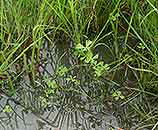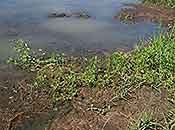Marsilea macrocarpa C.Presl
Synonyms |
Marsilea dregeana A. Braun |
|---|---|
Common name |
|
Description |
Rhizome slender to stout, 0.1–1.75 mm thick, set with long hairs or hairless, often with densely matted woolly hairs at the nodes. Floating form: stipe 15-30(-40) cm long, hairless. Leaflets often broader than long, (4–)7–25(–35) mm long, (3–)5–28(–40) mm wide, hairless, broadly obdeltate often with concave flanks, outer margin rounded, entire, with long brown suberose interstitial streaks on the lower surface. Dry land form: stipe 3-25 cm long, hairless. Leaflets often broader than long, (4–)7–25(–35) mm long, (3–)5–28(–40) mm wide, flanks straight or slightly concave, outer margins shallowly crenate to irregularly incised, slightly hairy when young. Sporocarps: several or solitary, fluctuating in size, 3.2-7 mm long, 3-5.5 mm high, 1.5-2 mm thick; elliptic or more or less rectangular to subcircular in lateral view, rectangular in vertical cross-section with the sides sometimes concave, grooved on the upper and outer side, slightly hairy; lateral ribs more or less visible in young specimens; lateral veins (as seen on the interior surface) not anastomosing; raphe always distinct, covering 1/3–1/2 (rarely 2/3) the length of the sporocarp base; lower tooth absent or only a very shallow hump, upper tooth a short hump or an obtuse point. Sporocarp set at an angle of 90° to almost 180° to the pedicel; pedicels (3.5–)7–12(–14) mm long, erect or arching, free, single, arising from the base of the stipe, usually with long soft hairs, rarely hairless. |
Notes | Can be distinguished by combination of very short upper tooth, groove on the upper and outer side and concave flanks of the sporocarp, free and solitary pedicels. |
Derivation | macrocarpa: with large fruits or sporocarps. |
Habitat | Areas with permanent or temporary ground water, seasonal vleis and pans, temporary grassland depressions, along streams, sometimes in running water. Seasonal pattern, dormant in dry season. |
Distribution worldwide | See African distribution. |
Distribution in Africa |
Angola, Botswana, Dem. Republic of Congo, Kenya, Namibia, South Africa, Tanzania , Uganda, Zimbabwe. |
Growth form |
Aquatic, terrestrial. |
Literature |
|


